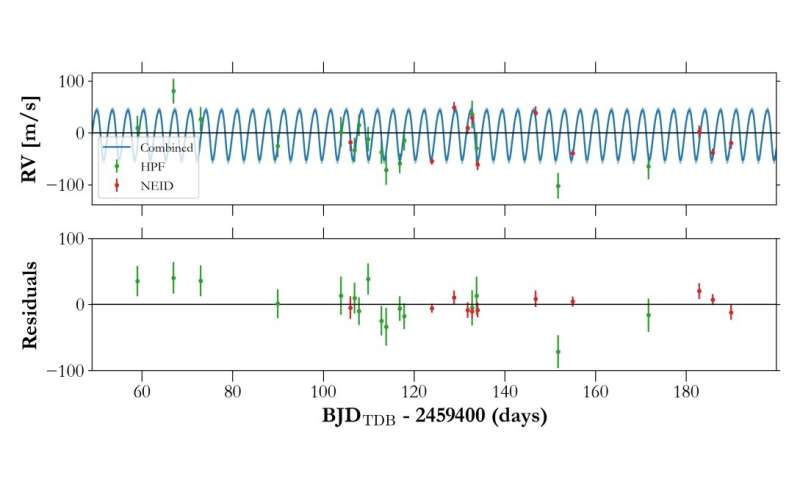Time series of RV observations of TOI-3757 with HPF (green) and NEID (red). The best-fitting model derived from the joint fit to the photometry and RVs is plotted in blue, including the 16-84 percent confidence interval in lighter blue. The bottom panel shows the residuals after subtracting the model. Credit: Kanodia et al., 2022.
Using NASA's Transiting Exoplanet Survey Satellite (TESS), astronomers from the Pennsylvania State University (PSU) and elsewhere have detected a new Jupiter-sized extrasolar world. The newfound exoplanet, designated TOI-3757 b, is slightly larger than Jupiter but more than three times less massive than the solar system's biggest planet. The finding is reported in a paper published March 15 on arXiv.org.
TESS is conducting a survey of about 200,000 of the brightest stars near the sun with the aim of searching for transiting exoplanets. It has identified over 5,400 candidate exoplanets (TESS Objects of Interest, or TOI), of which 199 have been confirmed so far.
A group of astronomers led by PSU's Shubham Kanodia has recently confirmed another TOI monitored by TESS. They report that a transit signal has been identified in the light curve of an M dwarf star known as TOI-3757. The planetary nature of this signal was confirmed by follow-up observations.
"We present the discovery and confirmation of TOI-3757 b, a Jovian sized planet, characterized using a combination of space based photometry from TESS, precise RVs [radial velocities] from HPF [Habitable-zone Planet Finder] and NEID [NN-explore Exoplanet Investigations with Doppler spectroscopy], ground based photometric observations from RBO [Red Buttes Observatory], and speckle imaging from NESSI [NN-Explore Exoplanet Stellar Speckle Imager]," the researchers wrote in the paper.
TOI-3757 b has a radius of about 1.09 Jupiter radii, while its mass is approximately 0.268 Jupiter masses. This yields a density of only 0.27 g/cm3, what makes it the lowest density planet orbiting an M dwarf known to date. The exoplanet orbits its host every 3.44 days, at a distance of some 0.038 AU from it. The equilibrium temperature of this alien world is estimated to be 759 K.
Located around 578 light years away from the Earth, the parent star TOI-3757 is an M dwarf of spectral type M0V, about 37 percent smaller and less massive than the sun. The star has a solar metallicity, is estimated to be 7.1 billion years old, and its effective temperature is at a level of 3,913 K. It was noted that TOI-3757 has the lowest stellar metallicity of all M dwarfs hosting gas giants.
Trying to explain the low density of TOI-3757 b, the authors of the paper offer two most plausible hypotheses. They assume that that low metallicity of the M dwarf could be responsible for the delayed on-set of gaseous runaway accretion before the protoplanetary disk dissipated or that it could be a result of an evolution mechanisms where the tidal heating causes the inflation of the planet due to its slightly eccentric orbit.
The researchers added that the second scenario could be verified by measuring the levels of methane and ammonia. Such study would help constrain the interior temperature of TOI-3757, which can provide insight into potential tidal heating.
More information: Shubham Kanodia et al, TOI-3757 b: A low density gas giant orbiting a solar-metallicity M dwarf. arXiv:2203.07178v2 [astro-ph.EP], arxiv.org/abs/2203.07178
© 2022 Science X Network
























